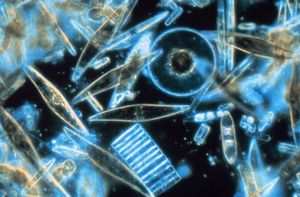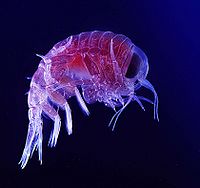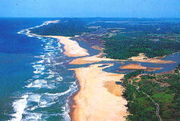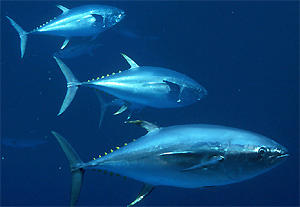Algal bloom
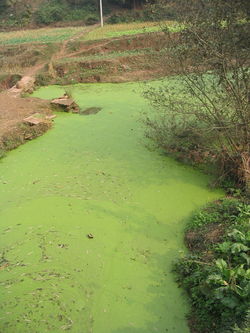
An algal bloom is a rapid increase or accumulation in the population of algae in an aquatic system. Algal blooms may occur in freshwater as well as marine environments. Typically, only one or a small number of phytoplankton species are involved, and some blooms may be recognized by discoloration of the water resulting from the high density of pigmented cells. Although there is no officially recognized threshold level, algae can be considered to be blooming at concentrations of hundreds to thousands of cells per milliliter, depending on the severity. Algal bloom concentrations may reach millions of cells per milliliter. Algal blooms are often green, but they can also be other colors such as yellow-brown or red, depending on the species of algae.
Bright green blooms are a result of blue-green algae, which are actually bacteria (cyanobacteria). Blooms may also consist of macroalgal, not phytoplankton, species. These blooms are recognizable by large blades of algae that may wash up onto the shoreline.
Of particular note are harmful algal blooms (HABs), which are algal bloom events involving toxic or otherwise harmful phytoplankton such as dinoflagellates of the genus Alexandrium and Karenia. Such blooms often take on a red or brown hue and are known colloquially as red tides.
Contents |
Freshwater algal blooms
Freshwater algal blooms are the result of an excess of nutrients, particularly phosphorus.[1] The excess of nutrients may originate from fertilizers that are applied to land for agricultural or recreational purposes, these nutrients can then enter watersheds through water runoff.[2] Excess carbon and nitrogen have also been suspected as causes.
When phosphates are introduced into water systems, higher concentrations cause increased growth of algae and plants. Algae tend to grow very quickly under high nutrient availability, but each alga is short-lived, and the result is a high concentration of dead organic matter which starts to decay. The decay process consumes dissolved oxygen in the water, resulting in hypoxic conditions. Without sufficient dissolved oxygen in the water, animals and plants may die off in large numbers.
Blooms may be observed in freshwater aquariums when fish are overfed and excess nutrients are not absorbed by plants. These are not generally harmful for fish, and the situation can be corrected by changing the water in the tank and then reducing the amount of food given.
Water treatment
Algal blooms sometimes occur in drinking water supplies. In such cases, toxins from the bloom can survive standard water purifying treatments. Researchers at Florida International University in Miami are experimenting with using 640-kilohertz ultrasound waves that create micropressure zones as hot as 3,700 °C. This breaks some water molecules into reactive fragments that can kill algae.[3]
Measurement
Algal blooms are monitored using biomass measurements coupled with the examination of species present. A widely used measure of algal and cyanobacterial chlorophyll concentration. Peak values of chlorophyll a for an oligotrophic lake are about 1-10 µg/l, while in a eutrophic lake they can reach 300 µg/l. In cases of hypereutrophy, such as Hartbeespoort Dam in South Africa, maxima of chlorophyll a can be as high as 3,000 µg/l.[4][5]
Tai Hu Algal Bloom
Lake Tai in Eastern China has had an algal bloom which has attracted the attention of the ENGO sector. Greenpeace China investigated the algal bloom at Lake Tai and took water samples. Of 25 samples, 20 were too polluted to be used to water plants or in factories.[6]
Harmful Algal Blooms
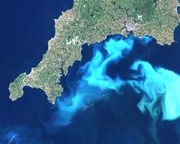
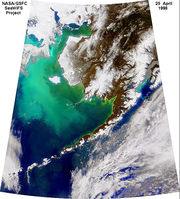
A harmful algal bloom (HAB) is an algal bloom that causes negative impacts to other organisms via production of natural toxins, mechanical damage to other organisms, or by other means. HABs are often associated with large-scale marine mortality events and have been associated with various types of shellfish poisonings.[7]
Background
In the marine environment, single-celled, microscopic, plant-like organisms naturally occur in the well-lit surface layer of any body of water. These organisms, referred to as phytoplankton or microalgae, form the base of the food web upon which nearly all other marine organisms depend. Of the 5000+ species of marine phytoplankton that exist worldwide, about 2% are known to be harmful or toxic.[8] Blooms of harmful algae can have large and varied impacts on marine ecosystems, depending on the species involved, the environment where they are found, and the mechanism by which they exert negative effects. Examples of common harmful effects of HABs include:
- the production of neurotoxins which cause mass mortalities in fish, seabirds and marine mammals
- human illness or death via consumption of seafood contaminated by toxic algae[9]
- mechanical damage to other organisms, such as disruption of epithelial gill tissues in fish, resulting in asphyxiation
- oxygen depletion of the water column (hypoxia or anoxia) from cellular respiration and bacterial degradation
Due to their negative economic and health impacts, HABs are often carefully monitored.[10][11]
HABs occur in many regions of the world, and in the United States are recurring phenomena in multiple geographical regions. The Gulf of Maine frequently experiences blooms of the dinoflagellate Alexandrium fundyense, an organism that produces saxitoxin, the neurotoxin responsible for paralytic shellfish poisoning. The well-known "Florida red tide" that occurs in the Gulf of Mexico is a HAB caused by Karenia brevis, another dinoflagellate which produces brevetoxin, the neurotoxin responsible for neurotoxic shellfish poisoning. California coastal waters also experience seasonal blooms of Pseudo-nitzschia, a diatom known to produce domoic acid, the neurotoxin responsible for amnesic shellfish poisoning. Off the west coast of South Africa, HABs caused by Alexandrium catanella occur every spring. These blooms of organisms cause severe disruptions in fisheries of these waters as the toxins in the phytoplankton cause filter-feeding shellfish in affected waters to become poisonous for human consumption.[12]
If the HAB event results in a high enough concentration of algae the water may become discoloured or murky, varying in colour from purple to almost pink, normally being red or green. Not all algal blooms are dense enough to cause water discolouration.
"Red Tides"
"Red tide" is a term often used to describe HABs in marine coastal areas,[13] as the dinoflagellate species involved in HABs are often red or brown, and tint the sea water to a reddish color. The more correct and preferred term in use is harmful algal bloom, because:
- these blooms are not associated with tides
- not all algal blooms cause reddish discoloration of water
- not all algal blooms are harmful, even those involving red discolouration[14]
Causes of HABs
It is unclear what causes HABs; their occurrence in some locations appears to be entirely natural,[15] while in others they appear to be a result of human activities.[16] Furthermore, there are many different species of algae that can form HABs, each with different environmental requirements for optimal growth. The frequency and severity of HABs in some parts of the world have been linked to increased nutrient loading from human activities. In other areas, HABs are a predictable seasonal occurrence resulting from coastal upwelling, a natural result of the movement of certain ocean currents.[17] The growth of marine phytoplankton (both non-toxic and toxic) is generally limited by the availability of nitrates and phosphates, which can be abundant in coastal upwelling zones as well as in agricultural run-off. The type of nitrates and phosphates available in the system are also a factor, since phytoplankton can grow at different rates depending on the relative abundance of these substances (e.g. ammonia, urea, nitrate ion). A variety of other nutrient sources can also play an important role in affecting algal bloom formation, including iron, silica or carbon. Coastal water pollution produced by humans and systematic increase in sea water temperature have also been suggested as possible contributing factors in HABs. Other factors such as iron-rich dust influx from large desert areas such as the Saharan desert are thought to play a role in causing HABs.[18] Some algal blooms on the Pacific coast have also been linked to natural occurrences of large-scale climatic oscillations such as El Niño events. While HABs in the Gulf of Mexico have been occurring since the time of early explorers such as Cabeza de Vaca,[19] it is unclear what initiates these blooms and how large a role anthropogenic and natural factors play in their development. It is also unclear whether the apparent increase in frequency and severity of HABs in various parts of the world is in fact a real increase or is due to increased observation effort and advances in species identification methods.[20][21]
Notable occurrences
- People may experience respiratory irritation (coughing, sneezing, and tearing) when the phytoplankton Karenia brevis is present along a coast and winds blow its toxic aerosol onshore. Swimming is usually safe, but skin irritation and burning is possible in areas of high concentration.[22]
- In 1972 a red tide was caused in New England by a toxic dinoflagellate Alexandrium (Gonyaulax) tamarense.[23]
- In 2005 the Canadian HAB was discovered to have come further south than it has in years prior by a ship called The Oceanus, closing shellfish beds in Maine and Massachusetts and alerting authorities as far south as Montauk (Long Island, NY) to check their beds.[24] Experts who discovered the reproductive cysts in the seabed warn of a possible spread to Long Island in the future, halting the area's fishing and shellfish industry and threatening the tourist trade, which constitutes a significant portion of the island's economy.
- Brittany, in France, is currently experiencing recurring algal booms caused by the high amount of fertilizer discharging in the sea due to intensive pig farming, causing lethal gas emissions that have already killed.[25]
See also
- Algae fuel
- Amnesic shellfish poisoning
- Brevetoxin
- Ciguatera
- Cyanotoxin
- Dead zone (ecology)
- Dinoflagellate
- Domoic acid
- Emiliania huxleyi
- Eutrophication
- Paralytic shellfish poisoning
- Pfiesteria
- Phytoplankton
- Neurotoxic shellfish poisoning
- Raphidophyte
- Saxitoxin
- Shiro alga carta
- Spring bloom
References
- ↑ Diersing, Nancy (May 2009). "Phytoplankton Blooms: The Basics". PDF. NOAA. http://floridakeys.noaa.gov/pdfs/wqpb.pdf. Retrieved 2009-08-24.
- ↑ Lathrop, Richard C.; Stephen R. Carpenter, John C. Panuska, Patricia A. Soranno, & Craig A. Stow (May 1, 1998). "Phosphorus loading reductions needed to control blue-green algal blooms in Lake Mendota". Canadian Journal of Fisheries and Aquatic Sciences (Toronto, Ontario, Canada: National Research Council of Canada) 55 (5): 1169–1178. doi:10.1139/cjfas-55-5-1169. http://article.pubs.nrc-cnrc.gc.ca/RPAS/rpv?hm=HInit&journal=cjfas&volume=55&afpf=f97-317.pdf. Retrieved April 13, 2008.
- ↑ Song, W.; Teshiba T., Rein K., and O'Shea K. E. (2005). "Ultrasonically induced degradation and detoxification of microcystin-LR (cyanobacterial toxin)". Environmental Science & Technology 39 (16): 6300–6305. doi:10.1021/es048350z.
- ↑ Zohary, T.; and R. D. Roberts (1990). "Hyperscums and the population dynamics of Microcystis aeruginosa". J. Plankton Res. 12 (2): 423–432. doi:10.1093/plankt/12.2.423.
- ↑ Bartram, J.; Wayne W. Carmichael, Ingrid Chorus, Gary Jones, and Olav M. Skulberg (1999). "Chapter 1. Introduction". Toxic Cyanobacteria in Water: A guide to their public health consequences, monitoring and management. World Health Organization. ISBN 0-419-23930-8. http://www.who.int/water_sanitation_health/resourcesquality/toxicyanbact/en/. Retrieved 2007-06-09.
- ↑ http://www.greenpeace.org/china/en/news/fertiliser-algae-taihu
- ↑ "Harmful Algal Blooms: Red Tide: Home". www.cdc.gov. http://www.cdc.gov/hab/redtide/. Retrieved 2009-08-23.
- ↑ Landsberg JH (2002) The effects of harmful algal blooms on aquatic organisms. Reviews in Fisheries Science, 10(2): 113–390 (2002)
- ↑ "Red Tide FAQ - Is it safe to eat oysters during a red tide?". www.tpwd.state.tx.us. http://www.tpwd.state.tx.us/landwater/water/environconcerns/hab/redtide/faq.phtml#q9. Retrieved 2009-08-23.
- ↑ Florida Fish and Wildlife Research Institute. "Red Tide Current Status Statewide Information". research.myfwc.com. http://research.myfwc.com/features/view_article.asp?id=9670. Retrieved 2009-08-23.
- ↑ "Red Tide Index". www.tpwd.state.tx.us. http://www.tpwd.state.tx.us/landwater/water/environconcerns/hab/redtide/. Retrieved 2009-08-23.
- ↑ "Red Tide Fact Sheet - Red Tide (Paralytic Shellfish Poisoning)". www.mass.gov. http://www.mass.gov/?pageID=eohhs2modulechunk&L=4&L0=Home&L1=Provider&L2=Guidance+for+Businesses&L3=Food+Safety&sid=Eeohhs2&b=terminalcontent&f=dph_environmental_foodsafety_p_red_tide&csid=Eeohhs2. Retrieved 2009-08-23.
- ↑ "Discover NOAA's Coral Reef Data". www8.nos.noaa.gov. http://www8.nos.noaa.gov/coris_glossary/index.aspx?letter=r. Retrieved 2009-08-22.
- ↑ Gregg W. Langlois, Pamela D. Tom. "Red Tides: Questions and Answers". U.S. Government. http://www.whoi.edu/fileserver.do?id=47320&pt=10&p=18553. Retrieved 2009-08-23.
- ↑ Adams NG, Lesoing M, Trainer VL (2000) Environmental conditions associated with domoic acid in razor clams on the Washington coast. J Shellfish Res 19:1007–1015
- ↑ Lam CWY, Ho KC (1989) Red tides in Tolo Harbor, Hong Kong. In: Okaichi T, Anderson DM, Nemoto T (eds) Red tides. biology, environmental science and toxicology. Elsevier, New York, pp 49–52.
- ↑ Trainer VL, Adams NG, Bill BD, Stehr CM, Wekell JC, Moeller P, Busman M, Woodruff D (2000) Domoic acid production near California coastal upwelling zones, June (1998). Limnol Oceanogr 45:1818–1833
- ↑ Walsh et al (2006). Red tides in the Gulf of Mexico: Where, when, and why? Journal of Geophysical Research 111, C11003, doi:10.1029/2004JC002813
- ↑ Cabeza de Vaca, Álvar Núnez. La Relación (1542). Translated by Martin A. dunsworth and José B. Fernández. Arte Público Press, Houston, Texas (1993)
- ↑ Sellner, K.G.; Doucette G.J., and Kirkpatrick G.J. (2003). "Harmful Algal blooms: causes, impacts and detection". Journal of Industrial Microbiology and Biotechnology 30 (7): 383–406. doi:10.1007/s10295-003-0074-9. PMID 12898390. http://www.springerlink.com/content/ptybc0qg8y4klr5c/.
- ↑ Van Dolah, F.M. (2000). "Marine Algal Toxins: Origins, Health Effects, and Their Increased Occurrence". Environmental Health Perspectives (Brogan &) 108 (suppl.1): 133–141. doi:10.2307/3454638. PMID 10698729. PMC 1637787. http://www.ehponline.org/docs/2000/suppl-1/133-141vandolah/abstract.html.
- ↑ University of Florida Marine and Natural Resources, IFAS Extension
- ↑ HAB 2000
- ↑ Moore, Kirk. "Northeast Oysters: The bigger danger, growers assert, would be the label of endangered". National Fisherman. http://www.nationalfisherman.com/month-content.asp?ItemID=1156&pcid=184&cid=196&archive=yes. Retrieved 2008-07-31.
- ↑ [1]
External links
- Harmful Algal Bloom information from the Florida Fish and Wildlife Conservation Commission Fish and Wildlife Research Institute
- Harmful Algae and Red Tide Information from the Coastal Ocean Institute, Woods Hole Oceanographic Institution
- Toxic Blooms: Understanding Red Tides, a seminar by the Woods Hole Oceanographic Institution
- Gulf of Mexico Dead Zone and Red Tides
- Human Illness caused by Algae, an excellent summary.
- Red Tide Report A Compilation of citizen based, media and official reports of the locations and severity of current Red Tide Blooms.
- Florida Red Tide Coalition A citizen based group dedicated to raising awareness of Red Tide, debunking myths, educating the public and taking action to promote our oceans' health and help stop red tide.
- Red Tide updates for the Gulf Coast of Florida provided by Mote Marine Laboratory in Sarasota, FL
- Harmful Algal Blooms Observing System (HABSOS)
- The Belgian Blooms Monitoring project
- Social & Economic Costs of Harmful Algal Blooms from "NOAA Socioeconomics" website initiative
- GEOHAB: The IOC-SCOR International Research Programme on the Global Ecology and Oceanography of Harmful Algal Blooms [SCOR and IOC of UNESCO]
- Harmful Algal Bloom Programme of the Intergovernmental Oceanographic Commission of UNESCO [IOC of UNESCO
- International Society for the Study of Harmful Algae [ISSHA
- NOAA Marine Biotoxins Program, National Oceanic and Atmospheric Administration
- California Program for Regional Enhanced Monitoring for PhycoToxins, California Department of Health Services and the University of California, Santa Cruz
- Red Tide FAQ, Florida's Fish and Wildlife Research Institute
- NIEHS study of airborne impacts of Florida red tide
- Washington State Shellfish Biotoxin Program
- Rescue Effort Under Way After 5th Dolphin Death
- abs-cbnnews.com, BFAR reiterates ban on eating shellfish from five provinces
- [2]
- Alexandrium fundyense at the Encyclopedia of Life
|
|||||||||||||||||||||||||||||||||||
|
|||||
|
||||||||||||||||||||||||||||||
|
|||||||||||||||||||||||||||||||||||||||||||
